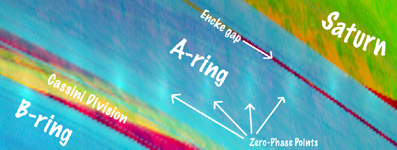|
COMETS EARTH JUPITER KUIPER BELT MARS MERCURY METEORITES NEPTUNE OORT CLOUD PLUTO SATURN SOLAR SYSTEM SPACE SUN URANUS VENUS ORDER PRINTS
PHOTO CATEGORIES SCIENCEVIEWS AMERICAN INDIAN AMPHIBIANS BIRDS BUGS FINE ART FOSSILS THE ISLANDS HISTORICAL PHOTOS MAMMALS OTHER PARKS PLANTS RELIGIOUS REPTILES SCIENCEVIEWS PRINTS
|
Related Documents
Download Options

Click on image for larger annotated version Astronomers have long known that Saturn's rings reflect sunlight most strongly when Earth is located directly between Saturn and the sun. Flat, shiny surfaces (like a mirror or a pond) can appear particularly bright when light reflects off them in a certain direction. Scientists call this "specular reflection," from the Latin word for mirror. However, even rough surfaces, like those of Earth's moon or Saturn's rings, can appear bright when the source of light is directly behind the observer's head, no matter what the orientation of the surface is. This latter phenomenon is known as the "opposition effect." Spectacular examples include the eyes of a cat, which seem to glow brightly when they are illuminated by a flashlight, or highway signs and reflectors that "light up" when they are caught in a car's headlights. On Aug. 16, 2006, as the Cassini orbiter flew directly between the sun and Saturn, its Visual and Infrared Mapping Spectrometer captured a sequence of images that vividly show this opposition brightening. Combined here into a mosaic, the images show -- from left to right -- a small, bright spot moving from the outermost B ring across the Cassini Division and all the way across the A ring. In each image, this spot is centered on the point in the rings directly opposite the sun. Theoretical models for the opposition effect suggest that it can be explained by light being scattered several times within the surfaces of individual, transparent, icy ring particles on scales of about 40 micrometers, or 1/500th of an inch. Similar effects are seen in laboratory studies of bright, finely-textured material such as snow or sugar crystals. In this mosaic, blue colors highlight the icy rings (2.35 microns), green represents sunlight reflected by the clouds of Saturn (2.86 microns) and red depicts thermal emission from the planet's interior (5.02 microns). The rings were observed while they were in front of the planet, producing a complex interplay of sunlight reflected from the rings and the shadows cast by the rings on the cloud tops of Saturn. The yellow-green sunlit clouds of Saturn are seen in the upper right corner of the mosaic beyond the outer edge of the A ring, and also through the 4,000-kilometer-wide (2,400 mile) Cassini Division in the left third of the mosaic. (Yellow indicates a mixture of reflected sunlight and thermal emission.) The shadowed regions of the planet, on the other hand, appear deep red because only thermal emission produced deep inside Saturn itself is visible. At exact opposition, the shadows of the rings are hidden behind the rings themselves, but away from this point shadows can be seen peeking out from behind the edges of the A and B rings into the Cassini Division, as well as beyond the outer edge of the A ring. If one looks closely, one can even trace the A ring's shadow behind the partly transparent A ring, as a faint purple band. Within this band, a thin blue-green line crossing obliquely behind the A ring is caused by sunlight passing through the narrow Encke Gap in the outer A ring. The Cassini spacecraft was at a distance of 254,000 kilometers (157,800 miles) from the center of Saturn when these images were taken, while the opening angle of the rings to the sun was 16.3 degrees. The image scale at the rings is approximately 70 kilometers (40 miles) per pixel. All nine images were taken over a period of 27 minutes, and the vertical dimension of the mosaic is 1.8 degrees. |
